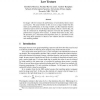Free Online Productivity Tools
i2Speak
i2Symbol
i2OCR
iTex2Img
iWeb2Print
iWeb2Shot
i2Type
iPdf2Split
iPdf2Merge
i2Bopomofo
i2Arabic
i2Style
i2Image
i2PDF
iLatex2Rtf
Sci2ools
85
Voted
BMVC
1998
1998
Improving Stereo Performance in Regions of Low Texture
In images with low texture the performance of conventional dense stereo can be poor. The usual solution to this is to use a large window but this itself can be problematic as the large window can blur important features and hence lead to errors in the disparity estimate. Here it is shown that, not only do connected set morphology operators overcome this problem, they perform best in regions of low texture. A further observation is that, since the operators give a heirarchical decompostion, there is a possibility of not only using these operators to choose a new window, but also to motivate a new matching method.
Related Content
| Added | 01 Nov 2010 |
| Updated | 01 Nov 2010 |
| Type | Conference |
| Year | 1998 |
| Where | BMVC |
| Authors | Kimberly Moravec, Richard Harvey, J. Andrew Bangham |
Comments (0)

